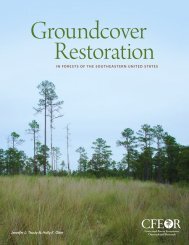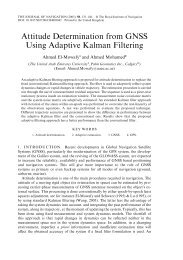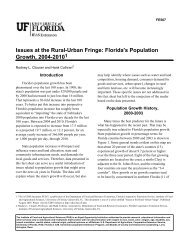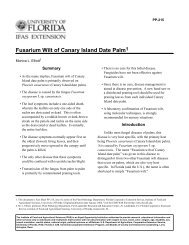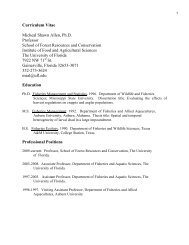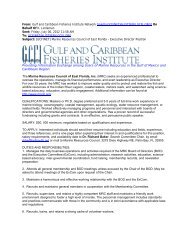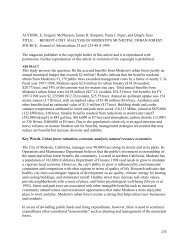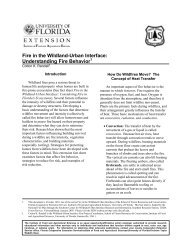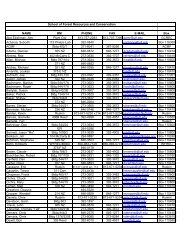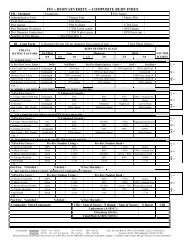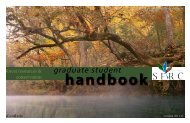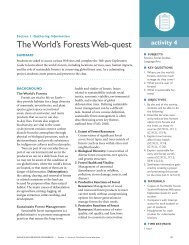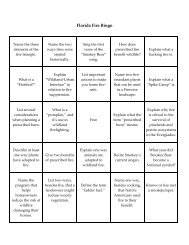Chapter 4: Plant Succession and Disturbances in the Urban Forest ...
Chapter 4: Plant Succession and Disturbances in the Urban Forest ...
Chapter 4: Plant Succession and Disturbances in the Urban Forest ...
You also want an ePaper? Increase the reach of your titles
YUMPU automatically turns print PDFs into web optimized ePapers that Google loves.
<strong>Chapter</strong> 4: <strong>Plant</strong> <strong>Succession</strong> <strong>and</strong> <strong>Disturbances</strong> <strong>in</strong> <strong>the</strong> <strong>Urban</strong> <strong>Forest</strong> Ecosystem 6<br />
<strong>the</strong>re before. Severe erosion, for <strong>in</strong>stance, may lead<br />
to a degraded ecosystem that will never fully recover<br />
to <strong>the</strong> prior condition without extremely costly<br />
<strong>in</strong>tervention, such as import<strong>in</strong>g soil.<br />
In urban areas <strong>the</strong> challenge is to determ<strong>in</strong>e <strong>the</strong><br />
appropriate natural disturbance regime to mimic<br />
<strong>and</strong>/or re<strong>in</strong>state.<br />
<strong>Succession</strong><br />
Figure 6.3<br />
Figure 6. Longleaf p<strong>in</strong>e ecosystems are dependent on<br />
frequent, low <strong>in</strong>tensity ground fires. Fires ma<strong>in</strong>ta<strong>in</strong> an open<br />
canopy (6.1) <strong>and</strong> an extremely diverse flora <strong>in</strong> <strong>the</strong> ground<br />
layer (6.2). In <strong>the</strong> absence of fires, o<strong>the</strong>r species, such as<br />
v<strong>in</strong>es <strong>and</strong> shrubs, are favored result<strong>in</strong>g <strong>in</strong> <strong>the</strong> loss of this<br />
ecosystem's natural diversity (6.3).<br />
Figure 7. The <strong>in</strong>termediate disturbance hypo<strong>the</strong>sis<br />
<strong>in</strong>dicates that species diversity is highest at <strong>in</strong>termediate<br />
frequencies or <strong>in</strong>tensities of disturbance.<br />
What is succession<br />
The changes <strong>in</strong> an ecosystem that follow a<br />
disturbance are collectively called succession.<br />
<strong>Succession</strong> is a dynamic <strong>and</strong> cont<strong>in</strong>uous process,<br />
often occurr<strong>in</strong>g gradually over time. <strong>Forest</strong><br />
succession is <strong>the</strong> change <strong>in</strong> species composition, age<br />
<strong>and</strong> size, <strong>and</strong> ecosystem structure <strong>and</strong> function over<br />
time.<br />
Let's consider <strong>the</strong> development of an ab<strong>and</strong>oned<br />
farm field <strong>in</strong> <strong>the</strong> Piedmont of <strong>the</strong> Sou<strong>the</strong>astern U.S.<br />
over time to demonstrate succession (Figure 8). This<br />
farm field is surrounded by p<strong>in</strong>e-hardwood forests,<br />
typical of this part of <strong>the</strong> country (8.1). Dur<strong>in</strong>g <strong>the</strong><br />
first year or two, annual forbs cover <strong>the</strong> field (8.2).<br />
<strong>Plant</strong>s such as goldenrod <strong>and</strong> asters follow <strong>the</strong><br />
second <strong>and</strong> third year (Perry 1994). In this early<br />
stage of succession, if we walk <strong>in</strong> this field, we can<br />
hear birds such as grasshopper sparrows <strong>and</strong><br />
meadowlarks (Meyers <strong>and</strong> Ewel, 1990).<br />
related. For example, volcanic eruptions or large<br />
meteor impacts (high <strong>in</strong>tensity) fortunately only<br />
occur rarely (at a low frequency).<br />
Some anthropogenic disturbances, such as<br />
global climate change, occur only at a very low<br />
<strong>in</strong>tensity. However, <strong>the</strong>se disturbances may be<br />
directional <strong>and</strong> may cause large cumulative effects<br />
over a long period of time. Because short-term<br />
effects are small, <strong>the</strong>y are very difficult to detect.<br />
If a disturbance is very <strong>in</strong>tense, ecosystems can<br />
be totally destroyed, as when a forest is converted to<br />
a park<strong>in</strong>g lot. The more <strong>in</strong>tense <strong>the</strong> disturbance, <strong>the</strong><br />
more difficult <strong>and</strong> costly it is to restore what was<br />
Figure 8.1<br />
The grass-forb stage would be gradually<br />
replaced by a shrub-p<strong>in</strong>e-seedl<strong>in</strong>g community that<br />
will last perhaps 15 to 20 years (without fur<strong>the</strong>r



